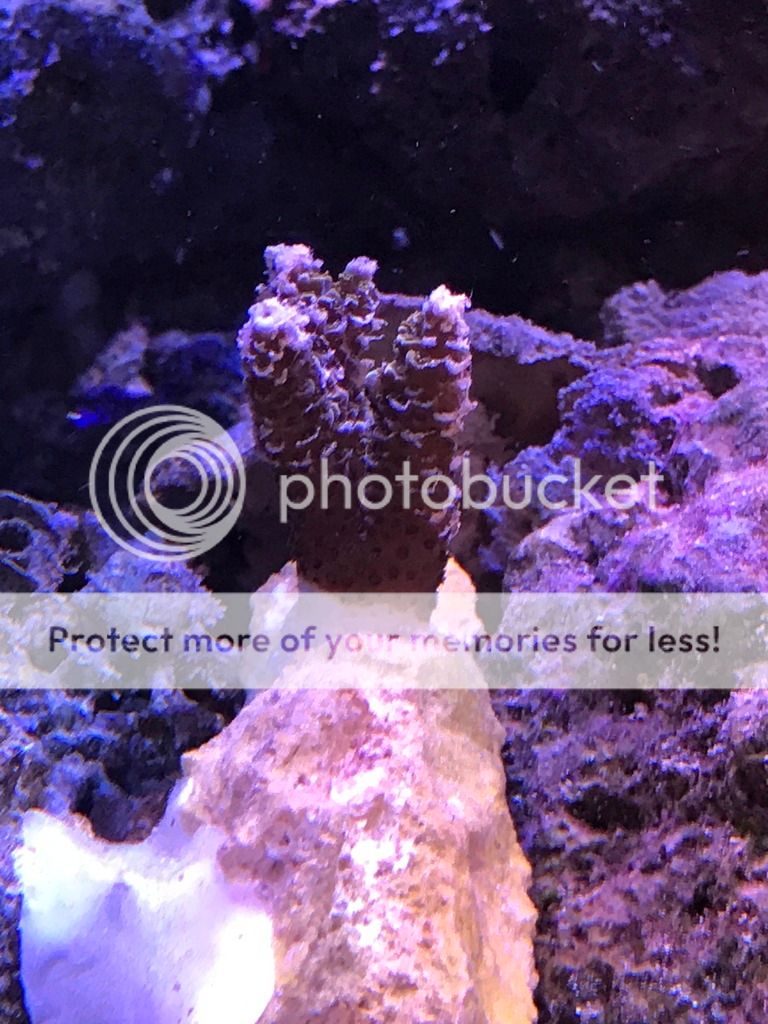HighestOlive
New member
I have been having a bit of trouble with my SPS STN'ing recently. At first I thought it was my pellet reactor stripping all of the nitrate and phosphate out of my tank leaving practically zero nutrients. So I pulled the pellet reactor and initially things looked like they were starting to turn around. and then some of the acros started STN'ing again. Here are the results of the testing that I just performed:
SG: 1.024
Temp: 77.2oF
pH 8.2
Alk: 8.3 dkh (Hanna Checker)
Ca: 445 ppm (Hanna Checker)
Mg: 1270 ppm (Salifert)
Nitrate 4 ppm (Red Sea Pro)
Phosphate 0.00 ppm (Milwaukee low range).
Does anyone else find it a bit odd that I have a pretty decent level of Nitrates but zero detectable phosphates? I feed fairly heavily as well. Should I be concerned that I can't detect phosphate or could this imbalance between nitrate and phosphate be causing some of the STN?
Some additional information:
I have tested my RO for chlorine and chloramines, both 0.
I am reading 1 ppm on my TDS meter on my RO Unit and have ordered new media to fix that.
Results of ICP testing that was performed 2 weeks ago (nothing stands out to me, CA was a bit high due to an over dose and has since fallen with water changes and not dosing).
Aluminum 0.11 ppm
Arsenic 0.01 ppm
Boron 2.44 ppm
Barium 0 .01 ppm
Beryllium 0 ppm
Bromine 87.9 ppm
Calcium 621.5 ppm
Cadmium 0 ppm
Cerium < 0.01 ppm
Chlorine 23683.82 ppm
Cobalt 41.28 ppm
Chromium 0.02 ppm
Copper 0 ppm
Iron 0 ppm
Gallium 0.95 ppm
Iodine 0.01 ppm
Potassium 452.25 ppm
Lanthanum 0.02 ppm
Lithium 0.62 ppm
Magnesium 1306.09 ppm
Manganese 0 ppm
Molybdenum 0.04 ppm
Sodium 9798.72 ppm
Nickel 0.06 ppm
Phosphorus 0.08 ppm
Lead < 0.01 ppm
Rubidium <0.01 ppm
Sulfur 332.51 ppm
Antimony 0 ppm
Selenium 0.01 ppm
Silicon <0.01 ppm
Tin 0.04 ppm
Strontium 6.83 ppm
Titanium 0 ppm
Thallium <0.01 ppm
Uranium 0.05 ppm
Vanadium 0.01 ppm
Tungsten 0 ppm
Zinc 0 ppm
Tank is a 90 gallon display that has been running since February, lite with 4 radion Gen 4 XR15 pros. Water movement is provided by 2 MP40 that alternate between reef crest and nutrient export. Rock work was moved from a previous tank that started to leak, but DSB is new for the most part (some of the old sand was mixed in to seed. Goes without saying there is also a skimmer.
Vortechs have been check to ensure there is no rust.
I haven't been running carbon, but I just started running it again today to see if there an unknown organic was causing issues.
I don't see any sign that this is an SPS pest. It really seems like a chemistry issue that I can't pinpoint. Any help that people can provide would be great. I would be happy to answer any additional questions.
SG: 1.024
Temp: 77.2oF
pH 8.2
Alk: 8.3 dkh (Hanna Checker)
Ca: 445 ppm (Hanna Checker)
Mg: 1270 ppm (Salifert)
Nitrate 4 ppm (Red Sea Pro)
Phosphate 0.00 ppm (Milwaukee low range).
Does anyone else find it a bit odd that I have a pretty decent level of Nitrates but zero detectable phosphates? I feed fairly heavily as well. Should I be concerned that I can't detect phosphate or could this imbalance between nitrate and phosphate be causing some of the STN?
Some additional information:
I have tested my RO for chlorine and chloramines, both 0.
I am reading 1 ppm on my TDS meter on my RO Unit and have ordered new media to fix that.
Results of ICP testing that was performed 2 weeks ago (nothing stands out to me, CA was a bit high due to an over dose and has since fallen with water changes and not dosing).
Aluminum 0.11 ppm
Arsenic 0.01 ppm
Boron 2.44 ppm
Barium 0 .01 ppm
Beryllium 0 ppm
Bromine 87.9 ppm
Calcium 621.5 ppm
Cadmium 0 ppm
Cerium < 0.01 ppm
Chlorine 23683.82 ppm
Cobalt 41.28 ppm
Chromium 0.02 ppm
Copper 0 ppm
Iron 0 ppm
Gallium 0.95 ppm
Iodine 0.01 ppm
Potassium 452.25 ppm
Lanthanum 0.02 ppm
Lithium 0.62 ppm
Magnesium 1306.09 ppm
Manganese 0 ppm
Molybdenum 0.04 ppm
Sodium 9798.72 ppm
Nickel 0.06 ppm
Phosphorus 0.08 ppm
Lead < 0.01 ppm
Rubidium <0.01 ppm
Sulfur 332.51 ppm
Antimony 0 ppm
Selenium 0.01 ppm
Silicon <0.01 ppm
Tin 0.04 ppm
Strontium 6.83 ppm
Titanium 0 ppm
Thallium <0.01 ppm
Uranium 0.05 ppm
Vanadium 0.01 ppm
Tungsten 0 ppm
Zinc 0 ppm
Tank is a 90 gallon display that has been running since February, lite with 4 radion Gen 4 XR15 pros. Water movement is provided by 2 MP40 that alternate between reef crest and nutrient export. Rock work was moved from a previous tank that started to leak, but DSB is new for the most part (some of the old sand was mixed in to seed. Goes without saying there is also a skimmer.
Vortechs have been check to ensure there is no rust.
I haven't been running carbon, but I just started running it again today to see if there an unknown organic was causing issues.
I don't see any sign that this is an SPS pest. It really seems like a chemistry issue that I can't pinpoint. Any help that people can provide would be great. I would be happy to answer any additional questions.

